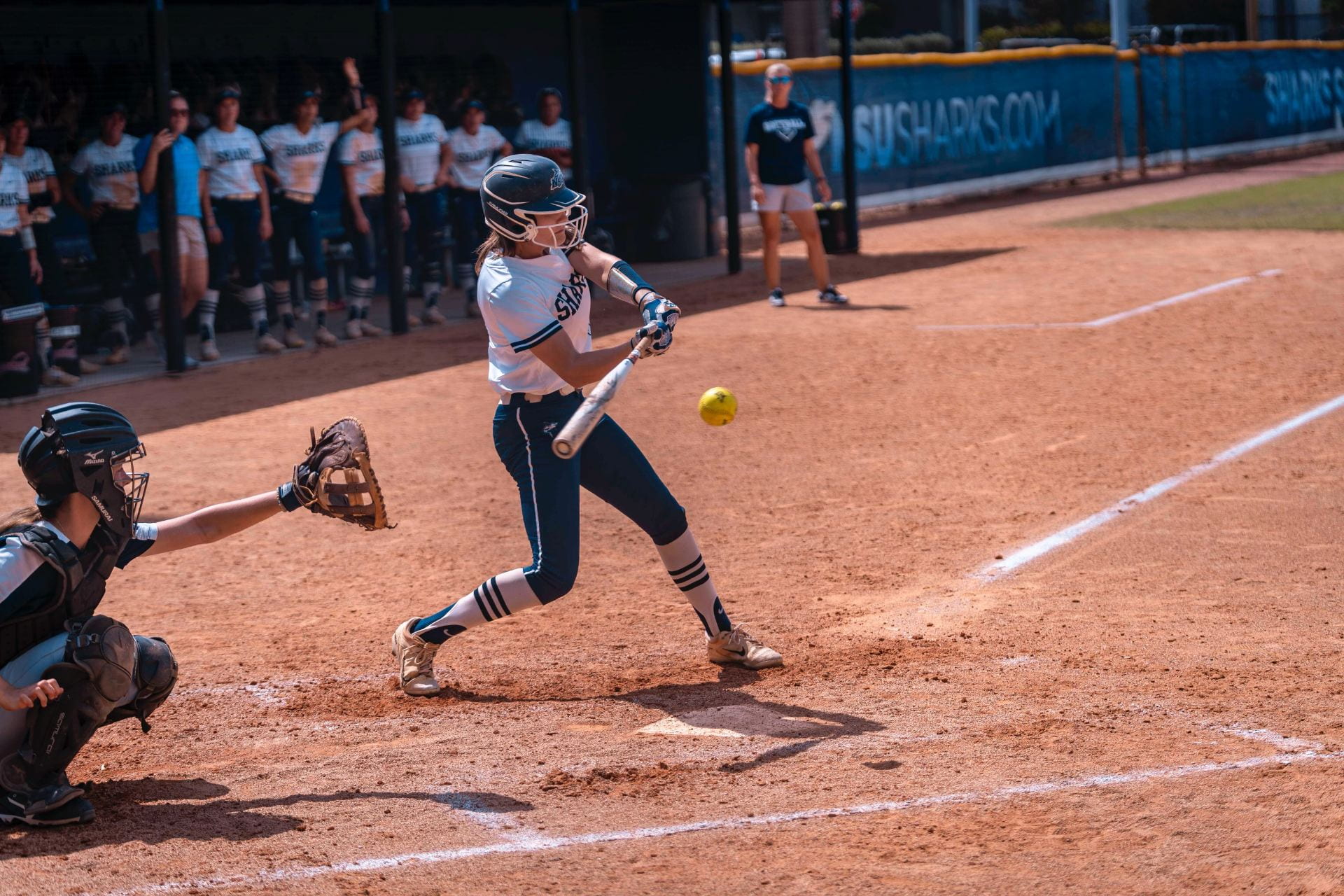
COURTESY OF NSU ATHLETICS
NSU senior Madison Fine collected three hits
and an RBI in the Sharks’ win over Palm Beach Atlantic.
Julie LeMaire, NSU head softball coach, uses analytics to evaluate data for pitching and hitting.
“The majority of the information is used for the coaching staff to track progression throughout the year and the athlete’s careers, but we also like to compare and contrast former, current and new athlete data to project data improvements and benchmarks,” LeMaire said.
LeMaire is one of the many coaches at NSU who has used statistics and analytics, a popular and growing trend used in the sports industry. Both professional and collegiate teams are using analytics to enhance player performance and collect and use data for increased on-field performance.
LeMaire and her team use a variety of data tools, such as Rapsodo Hitting 2.0, Rapsodo Pitching 2.0, Diamond Kinetics, Blast Motion, 6-4-3 Charts and Team Situational Stats. She highlights how each data tool is used for a different reason and a lot can be learned through studying analytics.
“6-4-3 Charts is the only tool we use to evaluate our hitters in game performance the same as our opponents’,” LeMaire said. “It gives us information such as pitches per plate appearance, whether a hitter takes the first strike or swings at it, or how a hitter performs with runners in scoring position.”
Kacie Ehinger, NSU head volleyball coach, uses analytics for injury prevention.
“We primarily use these in practice to keep our players healthy, as we can see how many times a player jumped during practice, then if we have a long match during the weekend, we can tone down practice to avoid overuse,” Ehinger said.
The volleyball team uses the wearable device Vert, allowing them to track how many times their players are jumping, touching and how much energy they utilize during practices. To measure her team’s success, Ehinger places emphasis on tracking hitting percentage.
“Hitting percentage is big for us, we always look at efficiency numbers,” Ehinger said. “We also look at points scored, specifically the points that we put up, not the other team’s errors.”
Joey Marino, NSU head men’s golf coach, acknowledges the importance of analytics and how they provide coaches with a different lens to view their athletes.
“You think you see every shot, but you don’t,” Marino said. “It gives you a good idea of how someone is playing, what their tendencies are and what to work on to get better.”
The golf team uses tools such as Trackman, Smash Factor, and Decade Golf Statistics, which help athletes in swing analysis, driving statics, pro shot statistics, putting, strokes gained and sheds insights on how players are improving.
“Players have a Trackman profile where they are able to see their statistics and I also have an in-depth dashboard that I occasionally meet with them to go over,” Marino said. “It gives me a chance to give them specific practice drills that they can use to improve those individual areas.”
While athletes are using the Trackman profile to improve their skills, they are also using it as a way to market themselves to scouts and professional teams.
“A lot of student athletes that are trying to play college golf add their Trackman profile into what they send coaches,” Marino said. “Their whole dashboard shows how much they are spending on their driver, how far it’s going, and swing analysis.”
To prevent injuries, the golf team uses Titleist Performance Institute testing by partnering with Pradeep Vanguri, associate professor of Health and Human Performance at NSU. Vanguri has done more than three years of TPI work with the men’s and women’s golf team.
“Pradeep does his own research and has a passion for injury prevention in golf, so the fact that we have somebody who is willing to do that for us on campus is unique,” Marino said. “We’re helping him with his research and he’s helping us.”
While the use of analytics has many benefits, there are risks to becoming “too data driven,” according to LeMaire.
“We do a good job of monitoring what we share with the girls because I feel too much information for them can also be harmful for the athlete,” LeMaire said. “However, we utilize data on the coaching side to prepare our scouting approach for our upcoming opponents.”
LeMaire is developing a healthy way to balance the use of analytics while also remaining in collaboration with her players.
“I believe the ideal combination in personal touch and data comes down to being able to compare and contrast the numbers with what we see and know visually,” LeMaire said. “Knowing what your players are capable of and playing to their strengths or to protect their weaknesses are just as important as the information you may pull from a team’s analytics.”

Be the first to comment on "Analytics at NSU: The science behind sports"